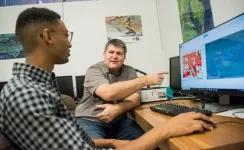(Press-News.org) Black patients are less likely than white patients to receive medical tests that doctors use to diagnose severe disease, such as sepsis, researchers at the University of Michigan have shown.
Because of the bias, some sick Black patients are assumed to be healthy in data used to train AI, and the resulting models likely underestimate illness in Black patients. But that doesn't mean the data is unusable—the same group developed a way to correct for this bias in data sets used to train AI.
These new insights are reported in a pair of studies: one published today in PLOS Global Public Health, and the other was presented at the International Conference on Machine Learning in Vienna, Austria, in July 2024.
In the PLOS study, the researchers found that medical testing rates for white patients are up to 4.5% higher than for Black patients with the same age, sex, medical complaints and emergency department triage score, a measure of the urgency of a patient's medical needs. The bias is partially explained by hospital admission rates, as white patients were more likely to be assessed as ill and admitted to the hospital than Black patients.
"If there are subgroups of patients who are systematically undertested, then you are baking this bias into your model," said Jenna Wiens, U-M associate professor of computer science and engineering and corresponding author of the study.
"Adjusting for such confounding factors is a standard statistical technique, but it's typically not done prior to training AI models. When training AI, it's really important to acknowledge flaws in the available data and think about their downstream implications."
The researchers found this bias in medical testing records from two locations: Michigan Medicine in Ann Arbor, Michigan, and one of the most widely used clinical datasets for training AI, the Medical Information Mart for Intensive Care. The dataset contains the records of patients visiting the emergency room in the Beth Israel Deaconess Medical Center in Boston.
Computer scientists need to account for these biases so that AI can make accurate and equitable predictions of patient illness. One option is to train the AI model with a less biased dataset, such as one that only includes records for patients that have received diagnostic medical tests. A model trained on such data might be inaccurate for less ill patients, however.
To correct the bias without omitting patient records, the researchers developed a computer algorithm that identifies whether untested patients were likely ill based on their race and vital signs, such as blood pressure. The algorithm accounts for race because the recorded health statuses of patients identified as Black are more likely to be affected by the testing bias.
The researchers tested the algorithm with simulated data, in which researchers introduced a known bias by relabeling patients identified as ill as "untested and healthy." The researchers then used this dataset to train a machine learning model, the results of which were presented at the International Conference on Machine Learning.
When the researcher-imposed bias was corrected with the algorithm, a textbook machine-learning model could accurately differentiate between patients with and without sepsis around 60% of the time. Without the algorithm, the biased data made the model's performance worse than random.
The improved accuracy was on par with a textbook model that was trained on unbiased, simulated data in which everyone was equitably tested. Such unbiased datasets are unlikely to exist in the real world, but the researcher's approach allowed the AI to work about as accurately as the idealized scenario despite being stuck with biased data.
"Approaches that account for systematic bias in data are an important step towards correcting some inequities in healthcare delivery, especially as more clinics turn toward AI-based solutions," said Trenton Chang, U-M doctoral student in computer science and engineering and the first author of both studies.
The research was funded by the National Institutes of Health.
Researchers from Michigan Medicine and the VA Center for Clinical Management Research in Ann Arbor also contributed to the PLOS study.
Studies:
Racial differences in laboratory testing as a potential mechanism for bias in AI: a matched cohort analysis in emergency department visits (DOI: 10.1371/journal.pgph.0003555)
From Biased Selective Labels to Pseudo-Labels: An Expectation-Maximization Framework for Learning from Biased Decisions
END
Accounting for bias in medical data helps prevent AI from amplifying racial disparity
Some sick Black patients are likely labeled as "healthy" in AI datasets due to inequitable medical testing
2024-10-30
ELSE PRESS RELEASES FROM THIS DATE:
MD Anderson Research Highlights for October 30, 2024
2024-10-30
HOUSTON ― The University of Texas MD Anderson Cancer Center’s Research Highlights showcases the latest breakthroughs in cancer care, research and prevention. These advances are made possible through seamless collaboration between MD Anderson’s world-leading clinicians and scientists, bringing discoveries from the lab to the clinic and back.
Epigenetic targets and genomic stem cell pathways drive adult hair regeneration
Retrotransposons are interspersed repeating sequences that make up over 40% of the human genome. Proper tissue regeneration requires ...
Three Baycrest leaders named 2024 Canada’s Most Powerful Women: WXN’s Top 100 Award winners
2024-10-30
Toronto, ON, October 30, 2024 – Three Baycrest leaders are among those named winners of Women Executive Network’s (WXN) prestigious 2024 Canada’s Most Powerful Women: Top 100 Awards, celebrating exceptional leadership and groundbreaking achievements that have meaningfully transformed their industries, companies, communities and country.
Dr. Allison Sekuler, President and Chief Scientist, Baycrest Academy for Research and Education and President and Chief Scientist, Centre for Aging + Brain Health Innovation, powered by Baycrest (CABHI)
Dr. ...
Scientists uncover new mechanism in plant cold sensing
2024-10-30
Cold damage is a major challenge in rice production, and identifying key gene modules in signaling pathways is a crucial means of addressing this issue. A Chinese research team has recently discovered a part of the plant’s cell membrane that helps plants sense when it's cold.
This cell membrane component, known as the COLD6-OSM1 module, triggers the production of a special molecule, 2',3'-cAMP, which helps plants sense and respond to low temperatures. This secondary messenger is a key upstream component that mediates the signaling pathway by directly responding to signals ...
Study shows natural regrowth of tropical forests has immense potential to address environmental concerns
2024-10-30
A new study in Nature finds that up to 215 million hectares of land (an area larger than Mexico) in humid tropical regions around the world has the potential to naturally regrow. That much forest could store 23.4 gigatons of carbon over 30 years and also have a significant impact on concerns like biodiversity loss and water quality. The study showed that more than half of the area with strong potential for regrowth was in five countries: Brazil, Mexico, Indonesia, China, and Colombia.
“Tree planting in degraded landscapes can be costly. By leveraging natural regeneration techniques, nations can meet their ...
After a heart attack, the heart signals to the brain to increase sleep to promote healing
2024-10-30
A heart attack can trigger a desire to get more sleep, allowing the heart to heal and reduce inflammation—and this happens because the heart sends special signals to the brain, according to a new Mount Sinai study. This research is the first to demonstrate how the heart and brain communicate with each other through the immune system to promote sleep and recovery after a major cardiovascular event.
The novel findings, published October 30 in Nature, emphasize the importance of increased sleep after a heart attack, and suggest that sufficient sleep should be a focus of post-heart-attack clinical management ...
Complexity of tumors revealed in 3D
2024-10-30
A new analysis led by researchers at Washington University School of Medicine in St. Louis has revealed detailed 3D maps of the internal structures of multiple tumor types. These cancer atlases reveal how different tumor cells — and the cells of a tumor’s surrounding environment — are organized, in 3D, and how that organization changes when a tumor spreads to other organs.
The detailed findings offer scientists valuable blueprints of tumors that could lead to new approaches to therapy and spark a new era in the field of cancer biology, according to the researchers.
The study is part of a group of 12 papers published Oct. 30 in the Nature suite of journals by members ...
Into the great wide open: How steppe pastoralist groups formed and transformed over time
2024-10-30
The wider Caucasus region, between the Black and the Caspian Seas, connects Europe, the Near East and Asia. It displays a huge geographic, ecological, economic, cultural, and linguistic range today, from the steppe zone in the north, the Caucasus mountains in the center, to the highlands of today’s Armenia, Georgia, Azerbaijan and Iran in the south. This diversity was no different in the past, where the archaeological record attests to many different influences from many surrounding regions.
“It is precisely this interface of different eco-geographic features ...
Determining precise timing of cellular growth to understand the origins of cancer
2024-10-30
Cancers are diseases of abnormal cellular growth, and although many are treatable or even curable, their origins are not necessarily clear. Understanding the precise timing of cellular events—as cells transition from normal to cancerous conditions—is key to uncovering new treatments or diagnostic opportunities.
Scientists from Vanderbilt University, led by Mirazul Islam, a graduate student mentored by Professor of Cell and Developmental Biology Ken Lau and Professor of Medicine Robert Coffey, have laid the groundwork for understanding and predicting the natural transition between precancers and cancer. They showed that colorectal cancer is likely to ...
Healthy brains suppress inappropriate immune responses
2024-10-30
The brain constantly engages in dialogue with the body’s immune system. Such communication appears aimed at ensuring a delicate balance between defending against injury and infection and guarding healthy tissue.
Now, scientists at Washington University School of Medicine in St. Louis have revealed how the two strike a healthy balance. The study, in mice, found that fragments of immune-stimulating proteins – dubbed guardian peptides – are produced by the brain and spinal cord of the central nervous system to maintain ...
Large meltwater accumulation revealed inside Greenland Ice Sheet
2024-10-30
A new study published in Nature unveils a surprising discovery: a substantial amount of meltwater is temporarily stored within the Greenland Ice Sheet during summer months. For the first time, an international group of researchers was able to quantify meltwater with positioning data. The finding challenges current models of how ice sheets contribute to global sea level rise.
The Greenland Ice Sheet is currently the largest single contributor to global sea-level rise, with the potential to raise the mean sea level by up to seven meters if it fully melts. While ...
LAST 30 PRESS RELEASES:
Tracing the quick synthesis of an industrially important catalyst
New software sheds light on cancer’s hidden genetic networks
UT Health San Antonio awarded $3 million in CPRIT grants to bolster cancer research and prevention efforts in South Texas
Third symposium spotlights global challenge of new contaminants in China’s fight against pollution
From straw to soil harmony: International team reveals how biochar supercharges carbon-smart farming
Myeloma: How AI is redrawing the map of cancer care
Manhattan E. Charurat, Ph.D., MHS invested as the Homer and Martha Gudelsky Distinguished Professor in Medicine at the University of Maryland School of Medicine
Insilico Medicine’s Pharma.AI Q4 Winter Launch Recap: Revolutionizing drug discovery with cutting-edge AI innovations, accelerating the path to pharmaceutical superintelligence
Nanoplastics have diet-dependent impacts on digestive system health
Brain neuron death occurs throughout life and increases with age, a natural human protein drug may halt neuron death in Alzheimer’s disease
SPIE and CLP announce the recipients of the 2025 Advanced Photonics Young Innovator Award
Lessons from the Caldor Fire’s Christmas Valley ‘Miracle’
Ant societies rose by trading individual protection for collective power
Research reveals how ancient viral DNA shapes early embryonic development
A molecular gatekeeper that controls protein synthesis
New ‘cloaking device’ concept to shield sensitive tech from magnetic fields
Researchers show impact of mountain building and climate change on alpine biodiversity
Study models the transition from Neanderthals to modern humans in Europe
University of Phoenix College of Doctoral Studies releases white paper on AI-driven skilling to reduce burnout and restore worker autonomy
AIs fail at the game of visual “telephone”
The levers for a sustainable food system
Potential changes in US homelessness by ending federal support for housing first programs
Vulnerability of large language models to prompt injection when providing medical advice
Researchers develop new system for high-energy-density, long-life, multi-electron transfer bromine-based flow batteries
Ending federal support for housing first programs could increase U.S. homelessness by 5% in one year, new JAMA study finds
New research uncovers molecular ‘safety switch’ shielding cancers from immune attack
Bacteria resisting viral infection can still sink carbon to ocean floor
Younger biological age may increase depression risk in older women during COVID-19
Bharat Innovates 2026 National Basecamp Showcases India’s Most Promising Deep-Tech Ventures
Here’s what determines whether your income level rises or falls
[Press-News.org] Accounting for bias in medical data helps prevent AI from amplifying racial disparitySome sick Black patients are likely labeled as "healthy" in AI datasets due to inequitable medical testing






